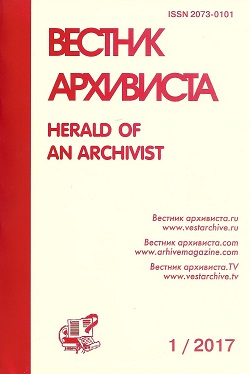Review
УДК 930.23+930.253+304.9+304.5+32.019.5+659.4+323.2+002.6.01/.09+930.22+002.63+321.02+321.8+34.096+351/354+351.76+351.85+351.96
doi 10.28995/2073-0101-2023-4-1272-1279
Rybakov, Roman V.
Omsk State Technical University, Omsk, Russian Federation
A Publication on the Role of Youth in Public Administration at the Turn of the 1930s
Abstract
This publication reviews a collective monograph on participation of the Soviet youth in the implementation of measures of control aimed at combating red tape and bribery and overcoming negative trends in the work of state and professional institutions. “Light Cavalry” is considered a successful, if flawed, project for preparing young people for management via communist education system. The focus is on detailed analysis of the tasks assigned to the youth organization and on the researchers’ conclusion about the impact of expanding cavalry assignments on the content and feasibility of the “Light Cavalry” plans. The results of the study are most valuable on the issue of perception of the “Light Cavalry” by the population. The authors demonstrate an abundance of myths and conflicting assessments of the organization’s activities in the mind of significant part of society. The reviewer underscores the value of the assessment of youth participation in mass political purges. The authors of the monograph conclude that unreasoning adherence to the pursued policy and unscrupulousness of the youth not only blighted and undermined the work of public and state structures, but also resulted in social tension. Quite logical, according to the reviewer, is the conclusion on ambiguous attitude of party and Komsomol functionaries towards the “Light Cavalry” activists, pulled apart by two opposing trends to independence and initiative and to compliance to the party and Komsomol control; the solution to this dilemma was not found in the 1920s. Unsurprisingly, as reviewer believes, the “Light Cavalry” did not find its place in the complex system of socio-political institutions. The failures gave rise to disappointment and disbelief, producing unfavorable effect on its composition. The situation only slightly improved in the 1930s, when the initiative of the young people was restricted, and their activities acquired greater control and planning. The reviewer concludes that the monograph is undoubtedly relevant, as it focuses not only on the problems of the youth movement of the 1920s–30s, but also on unconditional success of the “Light Cavalry” in developing the creative potential of the Russian youth; it manifested in identifying internal reserves of the industries, in increasing the efficiency of enterprises and organizations, all of which is in demand today.
Keywords
Soviet youth, Komsomol, All-Union Leninist Young Communist League, “Light Cavalry,” Soviet everyday life, social control.
Download the article: rybakov_doi
References
KAMALOVA, M. I. Tsennostnye ustanovki sovremennoi molodezhi i ikh rol' v gosudarstvennoi molodezhnoi politike [Value attitudes of modern youth and their role in the state youth policy. In Russ.]. IN: Sotsial'no-gumanitarnye znaniya, 2021, no. 5, pp. 314–320.
MARASOV, Yu. G. Obshchestvennaya i kontrol'naya deyatel'nost' v Tatarskoi ASSR v 1920-1934 gg. [Social and control activities in the Tatar ASSR in 1920–34. In Russ.]. IN: Vestnik Kazanskogo yuridicheskogo instituta MVD Rossii, 2020, no. 4(42), pp.402–408.
STADNIK, V. A. “Legkaya kavaleriya” KK-RKI: organizatsiya i uchastie komsomol'sko-molodezhnykh otryadov v sotsialisticheskoi modernizatsii Donbassa (konets 1920-kh – pervaya polovina 1930-kh godov). ["Light Cavalry" of the Rabkrin: organization and participation of Komsomol youth detachments in the socialist modernization of Donbass (late 1920s - first half of the 1930s). In Russ.]. IN: Sovremennaya nauchnaya mysl', 2022, no. 4, pp. 87–92.
TOMBU, D. V. Usloviya i riski politicheskoi identifikatsii rossiiskoi molodezhi [Conditions and risks of political identification of Russian youth. In Russ.]. IN: Vlast', 2018, V. 26, no. 1, pp. 91–98.
About the authors
Rybakov Roman Valerievich, PhD in History, associate professor, Omsk State Technical University, department of history, philosophy and social communications, assistant professor, Omsk, Russian Federation, +7-903-982-83-88, This e-mail address is being protected from spambots. You need JavaScript enabled to view it
Submitted 20.02.2023, published (for citation):
RYBAKOV, R. V. Izdanie o roli molodezhi v gosudarstvennom upravlenii na rubezhe 1920–1930-kh gg. [A Publication on the Role of Youth in Public Administration at the Turn of the 1930s. In Russ.]. IN: Vestnik arhivista / Herald of an Archivist, 2023, no. 4, pp. 1272-1279. doi 10.28995/2073-0101-2023-4-1272-1279














